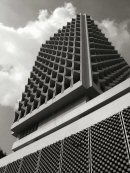The projects described below are open. In case you might be interested to work on one of these projects or for more information feel welcome to check with the indicated contact person.
Projects suggested for students in: SE – Structural Engineering and/or AE - Architectural Engineering
| |
Level: Master
|
Area: Wind Comfort in Cities (AE/SE)
|
|

|
Development of a wind comfort map
Photo-numerical evaluation of wind tunnel erosion tests in considering directional and seasonal distributed wind statistic
Description: In frame of new city developments the impact on environmental conditions is required by law. Many influences can be calculated or assessed with reasonable effort. However, to predict the wind condition in urban areas either expensive wind tunnel tests or complex numerical simulations are needed. In this respect the project shall investigate:
-
Effect of reducing wind tunnel model size on result
-
Potential of erosion tests for flow prediction
-
Method to consider wind statistics in the evaluation
-
Development of a standard for a "Wind Comfort Map"
The development of a method to create a Wind Comfort Map with a relative low involvement of a specilaised facility would give architechts and city planners a novel and atractive work tool to evaluate the environmental impact at an early stage of the development project.
Keywords: Wind tunnel testing; numerical evaluation of digital photos; rescaling digital information based on wind statistic; graphical result presentatio.
Prerequisites: Well routed in Matlab programming, graphical skills, experience in experimental work desireable
Contact: Holger Koss (hko@byg.dtu.dk)
|
| |
Level: Master
|
Area: Wind Comfort in Cities (AE/SE)
|
|

|
Wind control features for high-rise buildings
Influence of façade design on pedestrian-level wind conditions around a high-rise building
Description: High-rise buildings may influence significantly the airflow conditions around the building base and in the near neighbourhood. A major effect is in this connection is the downwash on the windward side of the building. Wind flow approaching at larger height over the city canopy is displaced at the high-rise building vertically downward the upstream façade causing unpleasant airflow at pedestrian level. Architects and city planners strive to avoid or at least reduce the magnitude of the downwash impact on the wind comfort.
This study focuses on investigating to what extent the roughness of the building façade may influence the downwash. Apart from façade roughness other architectural features will be tested for the same purpose. The investigation will be based on wind tunnel testing.
Keywords: Wind comfort in cities; building aerodynamic; wind tunnel testing; architectural façade features; downwash control.
Prerequisites: Experience in experimental work desireable, model building skills.
Contact: Holger Koss (hko@byg.dtu.dk)
|
| |
Level: Bachelor/Master
|
Area: Wind Comfort in Cities (AE)
|
|

|
Lessons to learn from medieval city architecture
Quality of medieval city geometric structure with respect to urban wind climate
Description: Back in the 1960s, when Massachusetts Institute of Technology (MIT) asked a new computer program to make a solution for the optimal sustainable town, it came up with an image of a medieval town.
Also in discussion of sustainable modern city architecture the image of a medieval city experiences recently a renaissance. The project shall research the main characteristics of a medevial city and filter out those elements relating to urban wind climate. The study may comprise but is not limited to:
-
Literature review on the subject.
-
Collection of relevant medieval city structures.
-
Climatic conditions of the selected cities.
-
Identification of wind relevant features.
-
Synthesizing these characteristics in a generic city design.
-
Link to modern design philosophy for a sustainable city structure.
The study is mainly based on literture research but may be supplemented with wind tunnel testing to investigate and compare medieval city wind climate.
Keywords: Wind climate in cities; medieval city structure; sustainable city design; comparative study; (wind tunnel testing)
Prerequisites: Knowledge in architectural engineering and city planning, model building skills.
Contact: Holger Koss (hko@byg.dtu.dk)
|